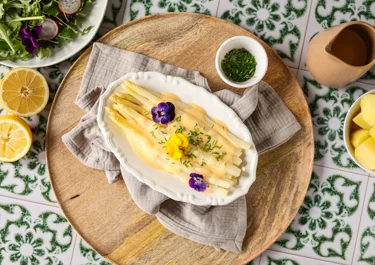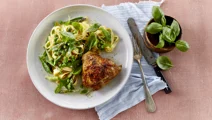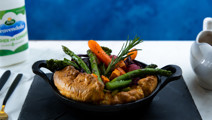Asparagus with hollandaise sauce

Explore a classic with our recipe for asparagus with hollandaise sauce and enjoy simplicity and sophistication, all in one. The delicate white asparagus meets an equally delicate hollandaise sauce, creating a harmony of subtle flavours. Serve it as a starter or side, and watch your guests pause for a moment, wondering if they have accidentally wandered into a fancy bistro.

Ingredients
Asparagus
White asparagus | 2 kilos |
|---|
Hollandaise sauce
Butter | 250 g |
|---|---|
A pinch of sugar | |
Egg yolks | 4 |
A splash of lemon juice | |
Water | 100 ml |
Salt | |
White pepper |
Instructions
Asparagus
Hollandaise sauce
To serve
Recommended information
Serving suggestion
Selecting the best asparagus
When picking your asparagus, opt for firm, smooth stalks with tightly closed tips – and try to choose ones of similar size so they cook evenly. Fresh white asparagus should have a slight sheen and feel moist at the cut ends, not dry or cracked. Avoid any that are limp, wrinkled, or have soft spots.
Make the hollandaise sauce thinner
If your hollandaise becomes too thick or starts to set, whisk in 1–2 teaspoons of lukewarm water to loosen it. To check the consistency, dip a spoon into the sauce – it should coat the back while still being pourable.
Clarify butter
To clarify butter, melt it slowly over low heat without stirring. With a spoon, skim off the foam that forms on top. Carefully pour the clear butterfat into another container, leaving the milky residue behind. For an even cleaner separation, strain it through a fine-mesh sieve or cheesecloth. Clarified butter makes hollandaise sauce smoother and more stable by removing milk solids and water. This helps the sauce emulsify more easily and lowers the risk of curdling.
Use a blender
A blender makes hollandaise sauce quicker and more stable. Unlike the traditional method, which thickens the yolks gradually over heat, this approach relies on continuous blending to form the emulsion. Blend the egg yolks, lemon juice, and water on low speed while slowly streaming in warm melted butter. Once incorporated, increase the speed briefly to emulsify fully. This results in a lighter, airier sauce rather than the rich, velvety texture of classic hollandaise. Just note that it will not be as warm as when done the traditional way.
FAQ: Questions about asparagus with hollandaise sauce
Hollandaise sauce may seem simple, but getting the correct consistency can be tricky, especially for beginners. Below are the answers to the most common questions to help you master the recipe with confidence.
Can hollandaise sauce be made ahead of time?
How can I prevent my hollandaise sauce from curdling?
Why does my hollandaise sauce separate?
Nutritional values
Nutritional value, per
2342 Kcal
| Fibre | 50 gram fibers |
| Protein | 48.9 gram |
| Carbohydrates | 37.9 gram |
| Fat | 225 gram |
Classic white asparagus with hollandaise sauce
Some recipes never go out of style, and white asparagus with hollandaise sauce is one of them. A true seasonal classic that has been enjoyed for generations. There is something almost ceremonial about peeling each spear, watching them turn tender in a pot of simmering water, and finally serving them up at their best.
The flavour is delicate, with a subtle sweetness and a hint of nuttiness, while the texture strikes the perfect balance between tender and firm. When the season arrives, there is no question about how to enjoy asparagus: with a generous drizzle of hollandaise, of course. And while white asparagus is a spring favourite, this recipe is just as good no matter the season.
Rich buttery sauce with subtle lemon flavour
Do not let the name fool you! Hollandaise might sound Dutch, but it is purely French, standing proudly as one of the five legendary mother sauces of French cuisine. This sauce is the definition of luxury: silky, buttery, and impossibly rich.
The flavour is smooth and indulgent, with a deep, buttery base lifted by a delicate lemony tang. That squeeze of lemon juice brings a hint of freshness and keeps it from feeling too heavy while helping it hold its velvety texture. A small detail – but details matter when making tasty traditional dishes like this.
Elegant side with minimal effort
White asparagus with hollandaise sauce is a brilliant, elegant appetiser that can shine on its own – or with other dishes. The mild, slightly nutty flavour of white asparagus goes hand in hand with smoked salmon, ham, or tender veal, with their savoury saltiness bringing out the best in the delicate spears.
Boiled potatoes are another favourite, soft enough to complement the asparagus while soaking up the hollandaise sauce. For something crisp, a lightly dressed salad keeps things bright, while pickled vegetables add a punchy, briny contrast that cuts through the richness.
We have plenty of other recipes for those who cannot get enough of asparagus! Our asparagus salad with strawberries is a refreshing option, perfect for summer lunches, while an asparagus casserole or a warm bowl of asparagus soup from peels is just what you need on a chilly evening.
Give the recipe a personal touch
Hollandaise sauce may be a classic, but that does not mean you cannot get creative. A pinch of freshly grated nutmeg sneaks in a warm, nutty undertone, making the sauce feel even more well-rounded. If you want a little heat, cayenne pepper adds a gentle warmth that lingers without overpowering the delicate asparagus.
For a citrus twist, try swapping the lemon juice for orange juice or even using a combination of both. Orange juice softens the acidity, adding a sweeter, more floral freshness that makes the dish feel lighter while still indulgent.
And if you are after something deeper and toastier, browning the butter before whisking it in adds a caramelised layer. The only thing to keep in mind is that browned butter slightly thickens the sauce, so whisk it in slowly to keep the texture smooth.


&format=webp)




&format=webp)
